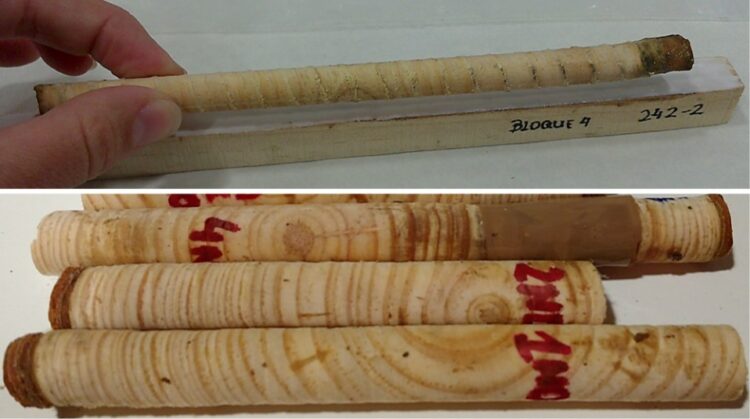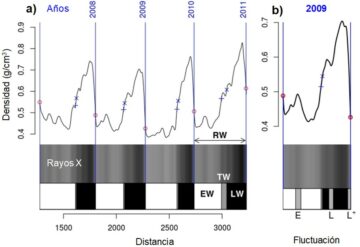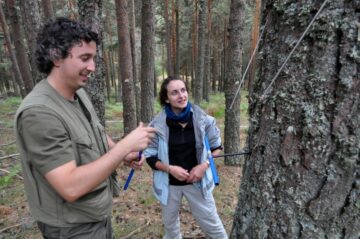
The study led by INIA (Madrid) and CETEMAS (Asturias), in collaboration with the Pablo de Olavide University of Seville (UPO) and the University of Coimbra (Portugal), has proven that the adaptation strategies of the Aleppo pine against extremely dry or very humid years depend more on the genetic and geographic origins than on the local weather conditions.
Due to this research, the different adaptation strategies of the species facing extreme droughts or very favourable climate years have been quantified for the first time under homogeneous climate conditions. For this purpose, the information contained in the annual growth rings has been used through dendrochronology and microdensitometry, identifying the plasticity mechanisms which show a high value information to design forest genetic improvement policies, as well as conservation and adaptation plans of Mediterranean pine forests against climate change. The work led by the researcher Andrea Hevia from CETEMAS (who is now working in the University of Huelva) and collaborator of UPO, has been recently published under the title: Which matters more for wood traits in Pinus halepensis Mill., provenance or climate? in the prestigious forestry journal Annals of Forest Science.

The authors of the study The authors of the paper have applied novel techniques to analyse the temporal changes in wood density during the life of the trees, as a reliable record of the environmental variations between years and within each year of growth. The study was carried out based on a trial established by the INIA-CIFOR in 1998 and maintained by the Spanish Forest Genetic Testing Network (GENFORED), coordinated for years by the researcher Ricardo Alía, co-author of the work. This trial has been maintained under controlled conditions and includes 56 populations from different Mediterranean origins of Aleppo pine, from which 18 out of 8 genetic origins from Spain, Italy, France and Greece were selected. Particularly, the study has analysed data on radial growth and the anatomical adaptations of each origin against climate during the annual formation of the ring as opposed to very dry or very humid years, i.e., the capacity of each genetic and geographic origins to take advantage of the few (dry) or many (humid) water resources available for its annual growth. This variation in anatomy during growth while facing seasonal changes in the annual climate is known as wood density fluctuations and is considered a novel result as an adaptation feature facing future climate change scenarios.
The plasticity and adaptation of the different origins through these rapid changes in the anatomy of the wood, indicate that annual fluctuations in density against favourable climate conditions normally occur in late summer and early autumn, and are more common in origins located in continental regions with a cold and dry climate. However, the frequency of fluctuations in spring during favourable years is more common in populations of wet origin such as France. On the other hand, both water availability and average temperature during the growing season are fundamental in the response of each source to extreme drought events. Therefore, the origins of coastal areas, with higher temperature and humidity, increase their adaptation in the final stage of annual growth during dry years, extending their growth window; as opposed to the more arid and continental origins of the Iberian Peninsula that adapt through low growth and high density during drought, shortening their annual growth season.

As Andrea Hevia explains, «it is fundamental to understand the space-time response of a species’ growth to extreme events and climate change, especially in Aleppo pine, one of the most important forest species in the Mediterranean. Understanding the role of geographical and genetic origins in the adaptation and vulnerability of forests to extreme droughts, or their resilience in favourable years, will make it possible to design better conservation strategies, as well as to facilitate forest improvement and the development of sustainable forest management measures adapted to climate change».
The importance of this study lies not only in the analysis of the annual growth series, but also in the variation within each year of the new structures that are produced during the growth of the trunk, from cell division in the vascular cambium -plant tissue-, and that are directly related to the capacity of adaptation or maladaptation of the hydraulic, structural and nutritional functions of the species in the face of extreme events and predicted climate change scenarios.
During the beginning of the growing season in spring, the cell structures are larger and have less wall thickness due to the better environmental conditions, which allows for greater hydraulic circulation (called early wood), where density fluctuations related to spring temperature in humid areas are formed; and they progressively decrease their size and increase the thickness of the walls at the end of summer and beginning of autumn (called late wood), to avoid hydraulic embolisms and improve the structural support against extreme droughts; forming changes in the anatomy to take advantage of the resources, mainly in more arid and dryer geographical origins. These properties also vary from year to year, but this study has shown that, under homogeneous climate conditions, the geographical and genetic origin determines the adaptive response to temperature and water availability during the growing season.
«The new knowledge generated in this work can be useful for the geographical zoning of the adaptation capacity of Aleppo pine forests, as well as for the identification of the origins currently better adapted to the scenarios foreseen for the 21st century in other regions, and this information can be used in programmes for the selection of resistant forest material for forest restoration», indicates Raúl Sánchez-Salguero, researcher and professor at the DendrOlavide laboratory of the UPO in Seville.
«Therefore, the genetic origins that show certain anatomical and physiological adaptations to drought, or that have a better capacity to recover growth in short periods of favourable conditions, will be decisive for carrying out plantations or forest restoration in an increasingly hot world with more extreme droughts, and based on these results we can introduce individuals with a guarantee of success,» the researchers explain.
This group of scientists from Spain and Portugal assures that research can contribute to improve the current models of forest management by incorporating this information about the capacity of adaptation and climate sensitivity in different regions of forest origin, in order to offer better predictions about how climate change will alter the growth of Mediterranean forests, and what possible adaptation or mitigation measures can be taken, in accordance with the Spanish Strategy for the Conservation and Sustainable Use of Forest Genetic Resources of the Ministries of Agriculture, Fisheries and Food and for the Ecological Transition of Spain.
Reference: Hevia, A., Campelo, F., Chambel, R., Vieira, J., Alía, R., Majada, J., Sánchez-Salguero, R. 2020. Which matters more for wood traits in Pinus halepensis Mill., provenance or climate? Annals of Forest Science https://doi.org/10.1007/s13595-020-00956-y





